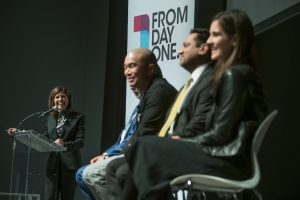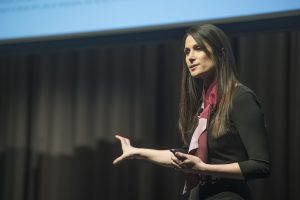Getting to Diversity: It Takes Data, Persistence, and a Willingness to Talk About It


Virtually all the leaders of Corporate America will tell you that diversity is an important goal. But that doesn't mean it's easy to talk about. “If you ever want a meeting to end early in your organization, bring up diversity. Everybody’s done,” quipped Tyronne Stoudemire, vice president of global diversity and inclusion for the Hyatt Corp.
Bringing up the topic can be like "touching the third rail," he said, because it's so sensitive. But he added that it needs to be part of the conversation all throughout companies, not just in the human-resources department. “This is not work for the weary, this is not work for the meek. This is for the strong of heart and those who are going to fight for the end, to close the gap,” said Stoudemire, speaking last week on a panel on "Innovation in Inclusive Hiring" at the From Day One conference in Chicago.
Underscoring the point, moderator Zoraida Sambolin, an anchor and reporter at Chicago's NBC 5 News, cited a new survey of chief diversity officers in which they said that they still don't get the power and respect they need in order to succeed in their mission. “It isn’t just the title or the role, you’re talking about influence," said Chad Nico Hiu, national director of diversity and inclusion for the YMCA. "Throwing someone in a room and saying, ‘Oh, you’re the chief diversity officer, go be a chief and be diverse,' it just doesn’t work that way.”
Change has to come from procedural and structural innovations, which means that diversity has to be part of almost every conversation about a company or organization's future, the panelists asserted. “If it’s going to be something that you’re going to tackle, it can’t just be the conversation about how we get to be more diverse. It literally has to pervade everything that you’re doing,” said Sayar Lonial, executive director of marketing and communications at the NYU Tandon School of Engineering.

NYU Tandon's incoming class was 43% female this year, about twice the percentage of typical engineering schools, thanks to energetic recruiting and efforts to make young women feel welcome on campus. For both businesses and schools, the diversity effort can start when future students or workers are young. “We need to focus on breaking down all the barriers, and there’s certainly large barriers among African-American and Latino communities in engineering,” Lonial said. “If they don’t have the skill set, we want to create K-12 STEM programs so they can make the decision to go into STEM, as opposed to having that decision made for them by a public-school system that doesn’t support it.”
Rather than take a subjective approach to diversity, companies can use technology to measure, implement and scale up. “Think of tech as simply a system that helps you say like, ‘OK, what are the data, what does that say my organization should do, how does that put a process in place?” said Lauren Ryan, vice president of new products at Greenhouse Software, which makes talent-acquisition software.
Ryan added that, while analyzing data to identify hiring gaps is a good strategy for C-suite executives, those on the lower rungs of the corporate ladder shouldn’t wait for a CEO to take up the cause. Hiring managers should build a diverse pipeline by seeking out applicants with unique perspectives, even if their inboxes are already flooded with resumes, she said. “Then you can kind of prove that it works and start to get buy-in for building something more holistic,” Ryan said.
Hyatt launched a program about three years ago called “Project Workforce 2025,” an initiative that outlines how the hotel chain will reach gender parity in terms of hires, promotions and exits over the next six years, Stoudemire said. The company championed the program after analyzing employee data and realizing that, while Hyatt was hiring women of color at a much faster rate than white men, those women were also leaving the company sooner. The problem? A lack of promotions among women of color.
In an assessment of organizations in general, Hiu pointed out that hierarchical groups can be exclusionary merely by their structure. “The structure that starts at the top has systemic challenges: when meetings are held, how meetings are held, what is the agenda, who moderates them and where, and what’s the goal. We all love to meet just to meet, but that’s probably not going to work if there’s not the crucial conversations that need to happen,” he said.

“Organizations that really want to do this understand [that] this is not just the nice thing to do. There’s a business imperative,” said Stoudemire. “We gotta figure it out, so we have to engage everybody.”
The YMCA emphasizes its commitment to diversity with the phrase, "For All," but not everyone understands the benefits right away, said Hiu. “I was leading a training [session] once and a 20-year-old program director stood up in the middle and challenged me and said, ‘For All, for what? So your pictures look diverse and pretty? What is the point?’ My sort of stumbling response was so that everyone can feel welcome," he said, asserting that organizations need to provide common ground because their members may differ in gender, ethnicity, politics, faith, and other ways.
In an earlier presentation, Tamara Snyder, executive vice president of employee experience at Edelman, said that 78% of the more than 33,000 global respondents in Edelman’s annual “Trust Barometer” survey this year agreed that how a company treats its employees is one of the best indicators of its trustworthiness. And trust matters. The vast majority of respondents agreed that, while a company's good reputation may get them to try a product, unless they trust the company, they will stop shopping the firm. “The bottom line is, when employees talk about the company, the world listens,” said Snyder.
Nona Tepper is a freelance journalist based in Chicago. Her work has appeared in the Washington Post, MarketWatch, Crain’s Chicago Business and elsewhere. Follow her on Twitter here.
The From Day One Newsletter is a monthly roundup of articles, features, and editorials on innovative ways for companies to forge stronger relationships with their employees, customers, and communities.